Transforming Indian Cities Through Safer Streets
Discover how non-motorized transport is transforming Indian cities with safer streets and vibrant public spaces.
How have non-motorized transport (NMT) modes such as walking and cycling evolved in India’s urban mobility story?
Walking and cycling have always been central to India’s mobility story. In my home base of Chennai, these modes have historically been the primary means of transport. When the Institute for Transportation and Development Policy (ITDP) started working in Chennai in 2009, approximately one-third (4.4 million) of all trips were made on foot or bicycle. Another third was by public transport, which involved walking to and from bus stops. Despite their prevalence, however, NMT was not prioritized on our streets.
Without high-quality footpaths and cycle tracks, these commuters face significant safety risks. India has one of the highest rates of road fatalities, especially among vulnerable road users like pedestrians and cyclists. Streets are often built as conduits for speeding vehicles, prioritizing motorized transport over people.
India has one of the highest rates of road fatalities, especially among vulnerable road users like pedestrians and cyclists.
Addressing this required radical change — reclaiming precious space from vehicular carriageways to create safe and continuous footpaths. In 2013, the city only focused on revamping the material used to build footpaths. We used this opportunity to redesign the street with wider footpaths, uniform carriageways, and organized parking. As a result, for the first time in 2013, the Greater Chennai Corporation (GCC) collaborated with urban designers to design and monitor the implementation of better streets.
In 2014, Chennai became the first Indian city to adopt a one-of-a-kind NMT Policy, laying the foundation for several progressive changes. This, I believe, was the first milestone in India’s NMT story, inspiring Pune and international cities such as Nairobi to follow suit.
In 2014, Chennai became the first Indian city to adopt a one-of-a-kind NMT Policy, inspiring Pune and international cities such as Nairobi to follow suit.
While street redesign projects have been ongoing in metro cities, over the years we have seen an increasing demand and acceptance for NMT work in cities like Pune, as well as tier-2 cities like Pimpri Chinchwad, Nagpur, and Coimbatore. Collectively, in the last few years, these cities, in technical partnership with ITDP, have built over 500 kilometers of streets aligned with NMT guidelines. Beyond infrastructure, they have also developed policy, established NMT committees, and regularly built the capacity of engineers and contractors to ensure sustained progress. This shift in priority towards walking and cycling in tier-2 cities was the second milestone.
The success in these cities highlighted the need for a national-level program to scale up efforts. When the pandemic struck in 2020, we saw an opportunity to accelerate this momentum, launching two national challenges – India Cycles4Change and Streets4People – by the Smart Cities Mission, Ministry of Housing and Urban Affairs (MoHUA), with ITDP providing technical support. We engaged with 117 cities, inspiring 33 to implement 570 kilometers of walking and cycling projects, with another 1400 kilometers still under development. Such a massive impetus for NMT was unheard of in Indian cities, and I believe this has been the third major milestone in India’s urban mobility journey.
Could you share two to three cases where NMT has been successfully integrated into Indian cities?
Chennai has a great story to tell. In 2019, the GCC in collaboration with Chennai Smart City Limited implemented a 1.4-kilometer-long pedestrian plaza in Pondy Bazaar in T. Nagar. The primary objective of this project was to optimize road space to provide pedestrian amenities and create traffic-free social spaces for the citizens of Chennai. Located in the bustling commercial hub of the city, this new pedestrian plaza, with footpaths, organized parking, and segregated seating spaces occupying two-thirds of the right of way, witnesses a daily footfall of over 4000 pedestrians.
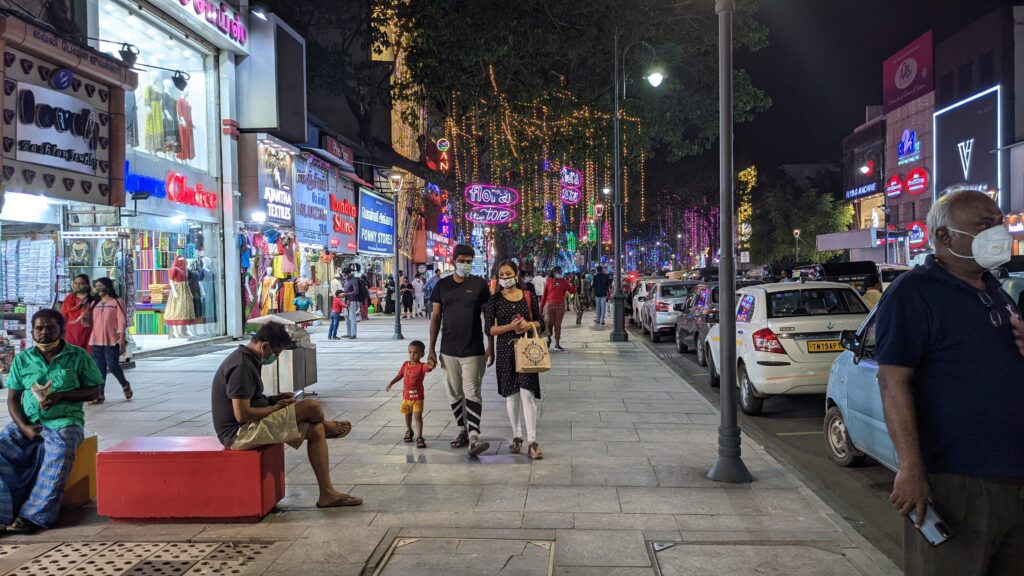
However, this was not always the situation. Before the NMT Policy catalyzed the implementation of this project, Pondy Bazaar was a commercial thoroughfare dominated by chaotic parking, dilapidated footpaths, and unsafe walking conditions. This was transformed into an inviting, safe, and vibrant open street mall where people can enjoy shopping and recreational activities for all age groups. What makes this a good example to emulate is that the city actively engaged with the local community and other government agencies every step of the way to build support and ownership for this project.
Another great example is Pimpri Chinchwad Municipal Corporation’s (PCMC) Linear Garden Street. This project reclaimed 38,000 square meters of space from the carriageway and front margins of private properties to create safe footpaths and cycle tracks. The Linear Garden, now a shaded promenade, has become a vibrant social hub where more residents gather for exercise and recreation, enhancing the community’s quality of life. Although it runs alongside a busy road, there are no conflicts between pedestrians and fast-moving traffic.
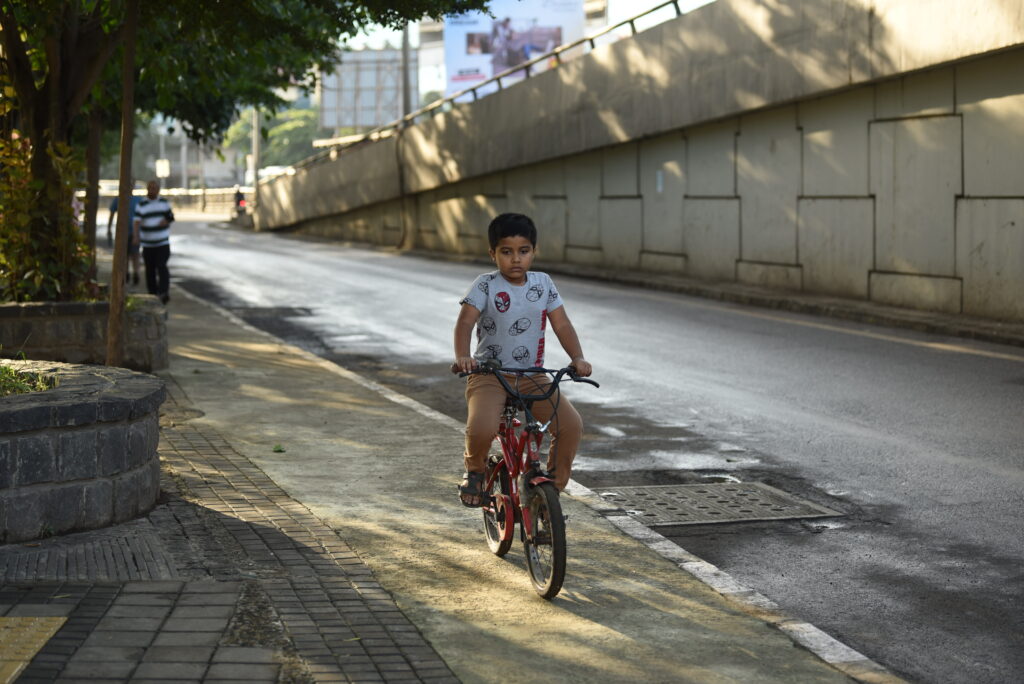
However, this NMT-centric street did not materialize overnight. PCMC achieved this through such foundational initiatives as the launch of the Urban Streetscapes Program in 2018 and the adoption of an NMT Policy in 2021. To date, the city has transformed over 100 kilometers of streets into healthier, safer spaces for pedestrians and cyclists. PCMC is also investing in projects like public bicycle-sharing schemes and public placemaking interventions – like the rejuvenation of spaces under flyovers, the insertion of seats, open gyms, and playgrounds along street edges, and the creation of safe junctions to further enhance the pedestrian and cyclist experiences in the city.
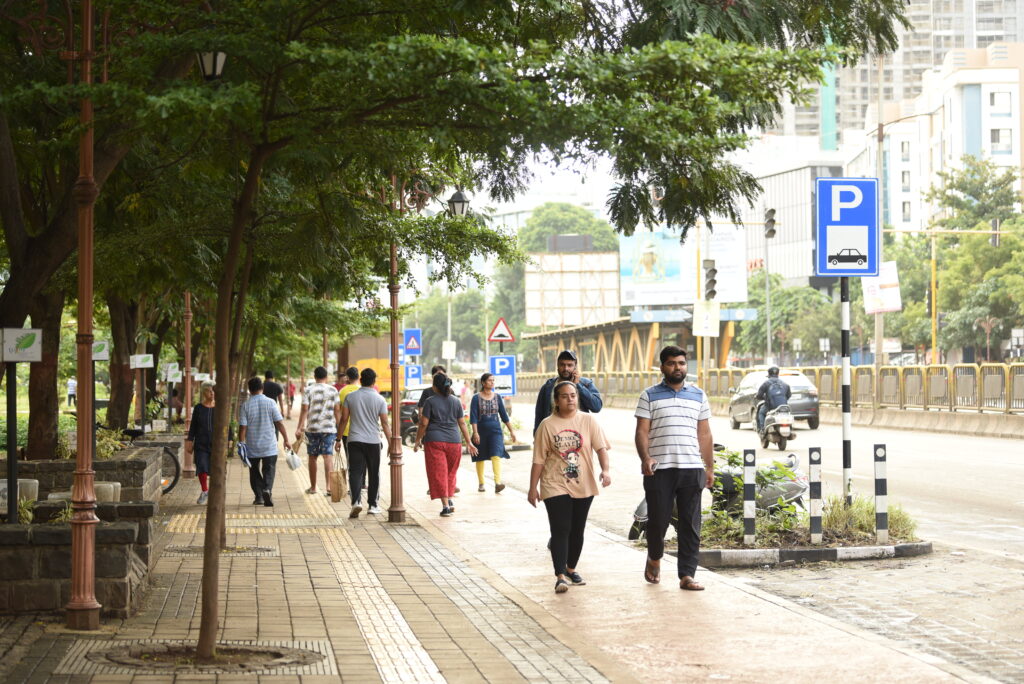
While these initiatives were city-level, at the national level, NMT initiatives were rolled out across multiple cities within four years through the India Cycles4Change and Streets4People Challenges. Through these initiatives, Indian cities devised new approaches to street design, keeping citizens at the center of the design process, working with them to test solutions, learn from these experiments, then scale up interventions across the city.
New Town Kolkata reclaimed street space for pedestrians and cyclists by reducing the number of motor vehicle lanes, transforming it into a permanent public space with food trucks, a library on wheels, pop-up carnivals, and photo exhibits after successful testing. Kohima reached out to its citizens to tackle their greatest challenge – parking! They took bold steps to transform on-street parking into vibrant community spaces with curbside seating and planters.
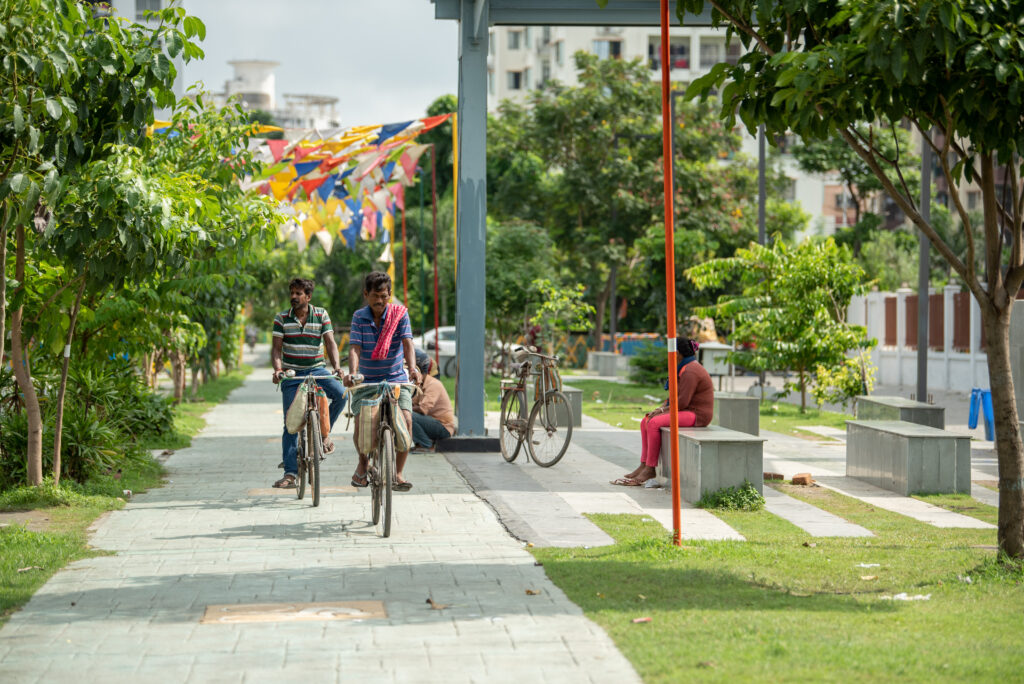
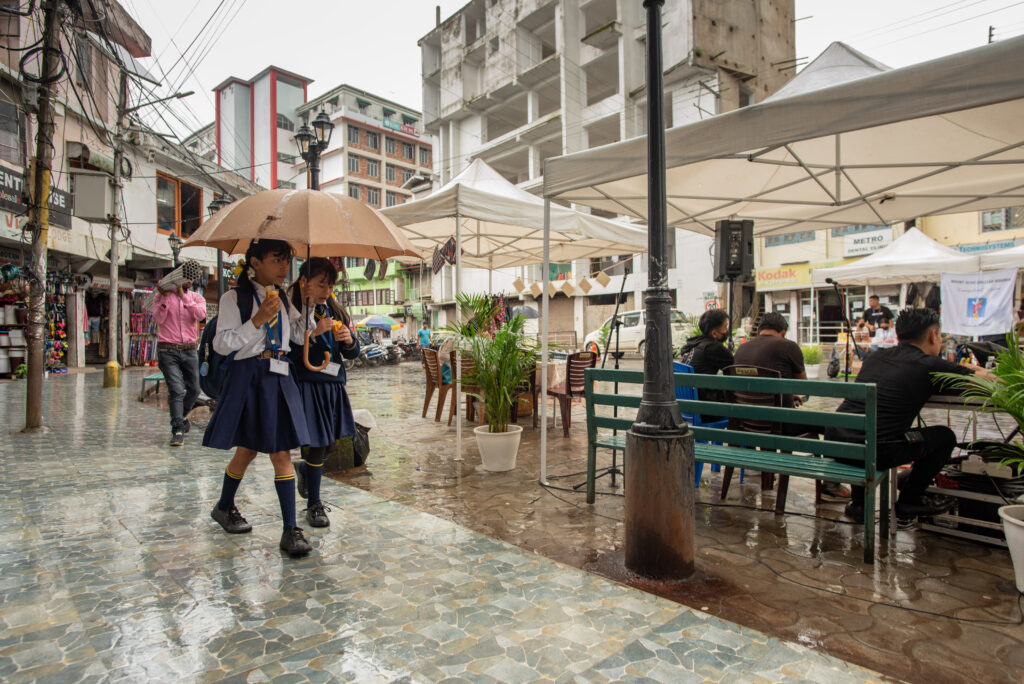
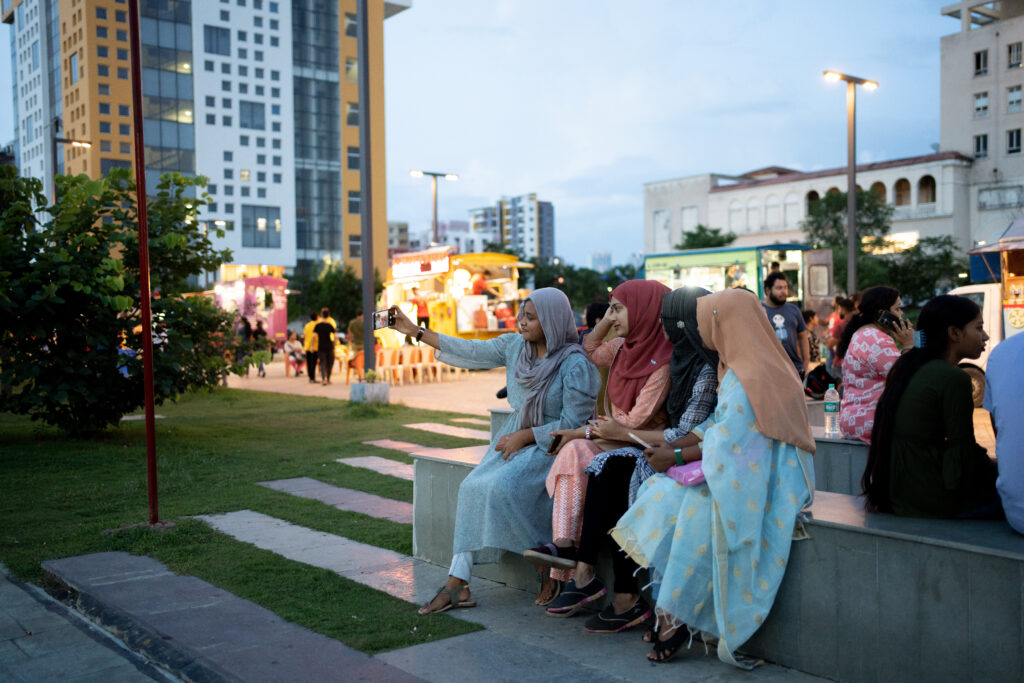
What are the primary challenges of integrating NMT into Indian cities?
There are three main challenges. First is the absence of sufficient budget allocations. The main reason is the lack of political will to prioritize fund allocation for walking and cycling. At the national level, there is a lot of focus on electrification, whether through the emphasis on electric vehicle policy or initiatives like the PM E-Bus Sewa scheme. However, we do not see the same focused attention on walking and cycling. We need stronger political support at all levels, which should be reflected in the allocation of transport funding.
At the state level, funds are allocated annually, with the roads department often getting the highest amount of funding. However, most of it is administered to highways or road expansion. The portion of funds essential for creating better streets and adding infrastructure like footpaths is often a small fraction of the total funds assigned to highways. Making sure that any urban street being redesigned or reconstructed is developed comprehensively should be the top priority, but this is often not the case. Having said that, there are exceptions, such as Pimpri Chinchwad and Chennai. Chennai’s NMT Policy adopted in 2014 mandated that at least 60% of transport budgets be allocated for street transformation.
The second challenge is the fragmented approach of different implementing agencies to street improvements and the lack of interdepartmental coordination. Many departments need to come together to transform a street, which requires coordination between them.
While the street may be under the ownership of the Urban Local Body or Highways Department, traffic is managed by the traffic police. Additionally, stormwater drains, sewage systems, and electrical lines are often planned by the relevant water supply, sewage, and electricity departments. Effective interdepartmental coordination is essential. Chennai’s Unified Metropolitan Transport Authority has been established to coordinate efforts among various agencies.
The third challenge is opposition from shopkeepers or resident associations, highlighting the need for proactive participatory planning. This resistance often stems from misinformation –specifically the belief that street redesign projects, especially those reducing carriageway widths, will eliminate on-street parking and hurt business sales. However, evidence from Chennai’s Pondy Bazaar tells a different story. Following the implementation of the project, retail shop owners reported a 15 to 20% increase in commercial sales between November 2020 and February 2021, compared to November 2018 to February 2019, before the project. This transformation disproved fears and demonstrated how well-designed public spaces can boost footfall and create thriving commercial hubs.
The Pondy Bazaar transformation disproved fears and demonstrated how well-designed public spaces can boost footfall and create thriving commercial hubs.
This challenge requires us to effectively convey the story of change to our stakeholders, including residents and shop owners. We must inspire them, address their concerns, revise the plans, and collaborate with citizens to transform our streets together.
How can some of these successes be scaled or replicated in other parts of India?
Presently, we see sustained action for street improvements from some pioneering cities and pilot implementation from many others. Multiple cities have adopted an NMT policy or a Healthy Streets policy.
First, I would like to see change at the state and national levels with a strengthened vision. Karnataka was the first state to launch an “Active Mobility Bill,” stating that any urban street constructed or improved should be designed with footpaths and cycle tracks where possible and completed as a healthy street. Unfortunately, this bill has not yet been adopted, become an act, and mandated. States must adopt NMT rules that ensure pedestrians are placed at the center of all decisions while redesigning existing or implementing new streets.
Capacity building of cities is also very important for wide-scale impact, as we saw with the MoHUA Challenges. This program catalyzed the implementation of many pilots. During the last national workshop of the Challenge, many city officials stated that it took them three years to understand the basics, advocate for change locally, and implement pilot street projects. They requested continued capacity building to help them scale up the pilots across their cities.
The third area requiring focus, for wide-spread adoption, is standardized street design regulation. Presently a few cities have developed standard guidelines for all future street work, but cities need to go beyond this to ensure the actualization of good street design. Bhubaneswar is a great example. In 2021, the city developed and adopted its Street Design Guidelines and identified this as the Bhubaneswar Street Design Regulations. The regulations provide a step-by-step approach to developing a “Complete Street,” which places importance on better distribution of road space for all user groups such as pedestrians, cyclists, public transport, and motor vehicles, and ensures a planned integration of underground/overground utilities, signage, and bus shelters. These regulations are legally bound, ensuring all agencies working with streets adhere to these rules, making it an effective way to create better streets.
